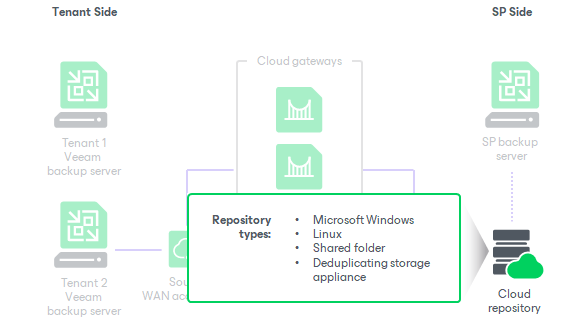 This is an archive version of the document. To get the most up-to-date information, see the current version.
This is an archive version of the document. To get the most up-to-date information, see the current version.Cloud Repository
The cloud repository is a storage location in the cloud where tenants can store their VM data. Tenants can utilize the cloud repository as a target for backup and backup copy jobs and restore data from the cloud repository.
The cloud repository is a regular backup repository configured in the SP backup infrastructure. The SP can use the following types of backup repository as a cloud repository:
- Microsoft Windows-based server
- Linux-based server (including hardened backup repository)
- Shared folder
- Deduplicating storage appliance: Dell Data Domain, ExaGrid and Quantum DXi
|
Hardened (immutable) backup repository is not supported for tenants that run Veeam Backup & Replication versions earlier than version 11.
|
The SP can expose cloud repository resources to one or several tenants. For each tenant, the SP allocates some storage space on the cloud repository. This storage space is consumed when the tenant runs data protection tasks targeted at the cloud repository.
The amount of space allocated to the tenant on the cloud repository is limited by a storage quota. If tenants must be able to use storage resources on the cloud repository for a limited period of time, the SP can also define a lease period for every tenant.
Being a multi-tenant storage resource, the cloud repository still appears as a logically separate backup repository to every tenant. Data in the cloud repository is segregated and isolated. Every tenant has its own folder on the cloud repository where tenant VM data is stored. Tenants do not know about other tenants who work with the cloud repository, and have no access to their data.
The tenant can have quotas on one or several cloud repositories configured by the SP. Several cloud repositories for one SP do not make up a pool of storage resources; they are used as separate backup infrastructure components. For example, if the tenant configures a backup job, the tenant can target it at only one cloud repository. All restore points created by this backup job will be stored on this cloud repository and will not be spread across several cloud repositories, even if the tenant has storage quotas on several cloud repositories.
Support for Scale-Out Backup Repository
Along with a simple backup repository, the SP can use a scale-out backup repository as a cloud repository. In this scenario, the SP can use the Capacity Tier functionality to offload tenant backups to a cloud-based object storage. To learn more, see Support for Capacity Tier.
The SP can also use the archive tier functionality to keep backups of rarely accessed tenant data in an additional tier of storage. To let tenants restore archived data, the SP must retrieve the data from the archive tier. To learn more, see Retrieving Tenant Data from Archive Tier.

Related Tasks